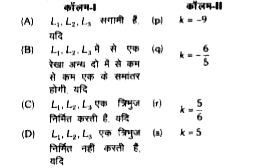यदि A=∣∣ ∣ ∣∣sin(θ+α)cos(θ+α)1sin(θ+β)cos(θ+β)1sin(θ+γ)cos(θ+γ)1∣∣ ∣ ∣∣ तब
A=0,θ के सभी मानों के लिये
A,θ का एक विषम फलन है
A=0,θ=α+β+γ के लिये
A,θ से स्वतंत्र है
The correct Answer is:D
Step by step video, text & image solution for यदि A=|(sin(theta+alpha),cos(theta+alpha),1),(sin(theta+beta),cos(theta+beta),1),(sin(theta+gamma),cos(theta+gamma),1)| तब by Maths experts to help you in doubts & scoring excellent marks in Class 12 exams.
Topper's Solved these Questions
- BOOK - ERRORLESS HINDICHAPTER - सारणिक तथा आव्यूह EXERCISE - JEE ADVANCED MORE THAN ONE CORRECT ANSWERS66videos
सारणिक तथा आव्यूह
- BOOK - ERRORLESS HINDICHAPTER - सारणिक तथा आव्यूह EXERCISE - JEE ADVANCED MORE THAN ONE CORRECT ANSWERS (Comprehension type questions) (Passage-I)6videos
सारणिक तथा आव्यूह
- BOOK - ERRORLESS HINDICHAPTER - सारणिक तथा आव्यूह EXERCISE - Solved Multiple Choice Questions ( आव्यूह के प्रकार, आव्यूह का बीजगणित)130videos
सारणिक तथा आव्यूह
- BOOK - ERRORLESS HINDICHAPTER - सरल रेखा EXERCISE - JEE ADVANCE (Matrix Match type questions)4videos
सरल रेखा
Similar Questions
सारणिक ∣∣ ∣∣abaα+bbcbα+caα+bbα+c0∣∣ ∣∣=0 यदि
04:23View Solutionमाना कि p एक विषम अभाज्य संख्या है तथा Tp,2×2 आव्यूहों का निम्न समुच्चय है
Tp={A=[abca]:a,b,c∈{0,1,2,.............p−1}}
Tp में ऐसे A की संख्या जो सममित या विषम सममित अथवा दोनों प्रकार के हो एवं जिनके लिए det(A),p से विभाज्य है, निम्न है02:37View Solutionयदि M=[1223] और M2−λM−I2=0 तब λ=
02:48View Solution 09:25View Solution
09:25View SolutionIf cos alpha+cos beta=a sin alpha+sin beta=balpha-beta=2 theta then (cos3 theta)/(cos theta)=
View SolutionIf alpha+beta+gamma=2 theta, then cos theta+cos(theta-alpha)+cos(theta-beta)+cos(theta-gamma)
View SolutionIf α,β,γ do not differ by a multiple of π and if cos(α+θ)sin(β+γ)=cos(β+θ)sin(γ+α)=cos(γ+θ)sin(α+β)=k Then k equals to
06:02View SolutionIf A=∣∣ ∣ ∣∣sin(θ+α)cos(θ+α)1sin(θ+β)cos(θ+β)1sin(θ+γ)cos(θ+γ)1∣∣ ∣ ∣∣, then
02:48View Solutionनिम्नलिखित कथनो पर विचार कीजिए ।
I . ∣∣ ∣ ∣∣cos(θ+α)cos(θ+β)cos(θ+γ)sin(θ+α)sin(θ+β)sin(θ+γ)sin(β−γ)sin(γ−α)sin(α−β)∣∣ ∣ ∣∣,θ से स्वतंत्र होगा ।
II. यदि f(θ)=c तबf(θ),θ से स्वतंत्र होगा ।
उपरोक्त कथनो में से कौन - सा /से कथन सही है/है ?09:04View SolutionIf 2(cos(α−β)+cos(β−γ)+cos(γ−α)+3=0, prove that
dαsin(β+θ)sin(γ+θ)+dβsin(α+β)sin(β+θ)+dγsin(α+θ)sin(β+θ)=0,
where, 'θ' is any real angle such that α+θ,β+θ,γ+θ are not the multiple of π.02:34View SolutionIf α+β+γ=2θ, then cosθ+cos(θ−α)+cos(θ−β)+cos(θ−γ)=
05:39View SolutionSuppose α,β,γ,θεR and
A(α,β,γ,θ)=∣∣ ∣ ∣∣cos(α+θ)sin(α+θ)1cos(β+θ)sin(β+θ)1cos(γ+θ)sin(γ+θ)1∣∣ ∣ ∣∣
Numerical value of A(−π2,0,π2,2π13) is04:30View SolutionIf alpha+beta+gamma=2theta Then costheta+cos(theta-alpha)+cos(theta-beta)+cos(theta-gamma) Is equal
05:47View SolutionIf α+β+γ=2θ, prove that cosθ+cos(θ−α)+cos(θ−β)+cos(θ−γ)=4(cos(α2)cos(β2)cos(γ2))
04:02View SolutionIf A=|(sin(theta+alpha),cos(theta+alpha),1),(sin(theta+beta),cos(theta,beta),1),(sin(theta+gamma),cos(theta+gamma),1)| Then
05:06View Solution

